Abstract
The left ventricular response to severe exercise was studied by telemetering direct measurements of left ventricular diameter (D) and pressure (P) and aortic blood flow from healthy dogs running at speeds up to 30 mph in the field. Severe exercise increased cardiac output from 101 to 478 ml/kg per min, heart rate from 95 to 297 beats/min, stroke volume from 31 to 44 ml, left ventricular isolength (iso) systolic pressure from 120 to 186 mm Hg, left ventricular end diastolic pressure from 6 to 18 mm Hg, and left ventricular end diastolic diameter from 58.9 to 60.1 mm, while end systolic diameter decreased from 53.0 to 52.2 mm. Two indices of myocardial contractility, (dP/dt)/P increased from 37 to 92 sec−1, while dD/dt, the velocity of myocardial fiber shortening at isolength, rose from 54 to 119 mm/sec. All of these changes were statistically significant. When, in resting dogs, heart rate was first raised to exercise levels by electrical stimulation, severe exercise subsequently increased left ventricular end diastolic diameter more profoundly, from 55.7 to 59.7 mm, while end systolic diameter remained constant and the increases in left ventricular pressure, (dP/dt)/P and velocityiso were roughly comparable to those occurring during exercise in spontaneous rhythm. After propranolol, 1.0 mg/kg, severe exercise resulted in significantly smaller increases in cardiac output (from 82 to 240 ml/kg), in heart rate (from 87 to 186 beats/min), in left ventricular pressureiso (from 122 to 150 mm Hg), in (dP/dt)/P (from 32 to 44 sec−1), in velocityiso (from 47 to 59 mm/sec), and in slightly greater increases in end diastolic diameter, from 59.8 to 62.0 mm and pressure from 8 to 22 mm Hg, while end systolic diameter did not change significantly.
Thus, the left ventricle responds to severe exercise with near maximal increases in heart rate and contractility, while significant increases in end diastolic diameter (Frank-Starling mechanism) and stroke volume occur as well. When heart rate was held constant severe exercise produced similar increases in contractility but end systolic size failed to diminish and the increases in end diastolic size were greater. Beta adrenergic receptor blockade interfered with the chronotropic and particularly the inotropic response to severe exercise and while the participation of the Frank-Starling mechanism was somewhat greater, the latter was not sufficient to increase cardiac output normally.
Full text
PDF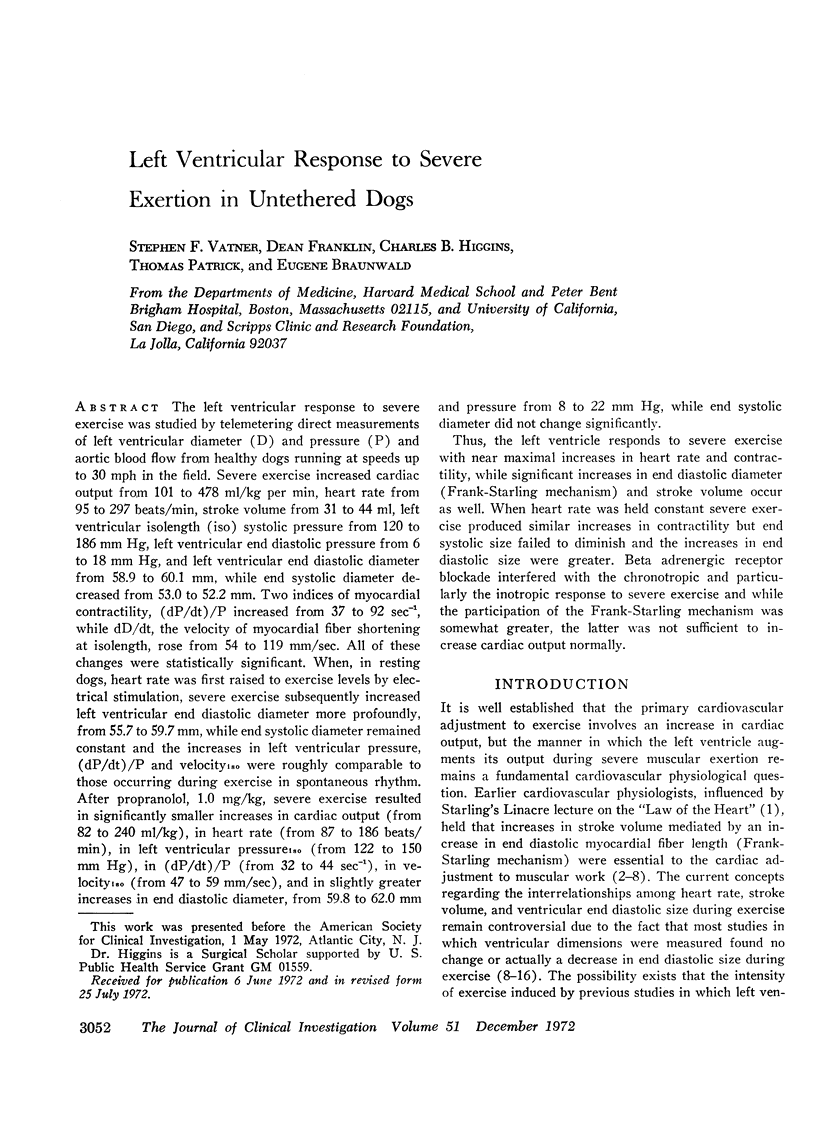
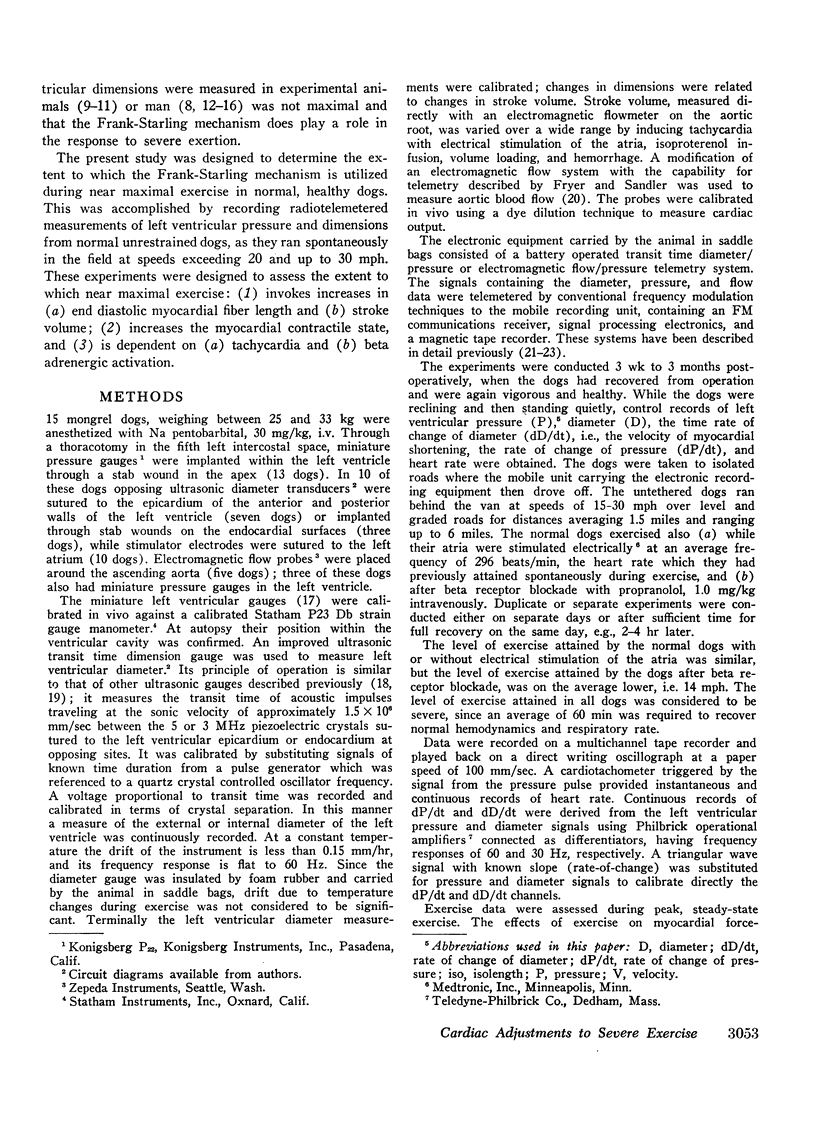
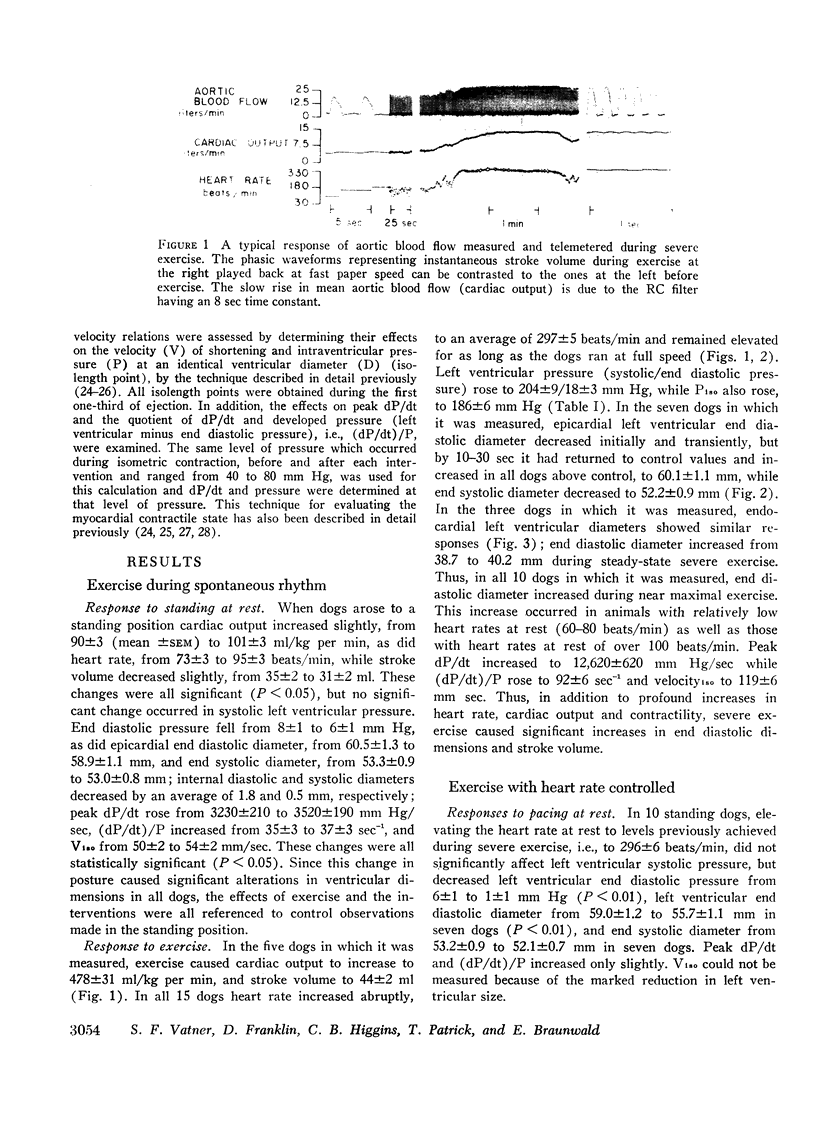
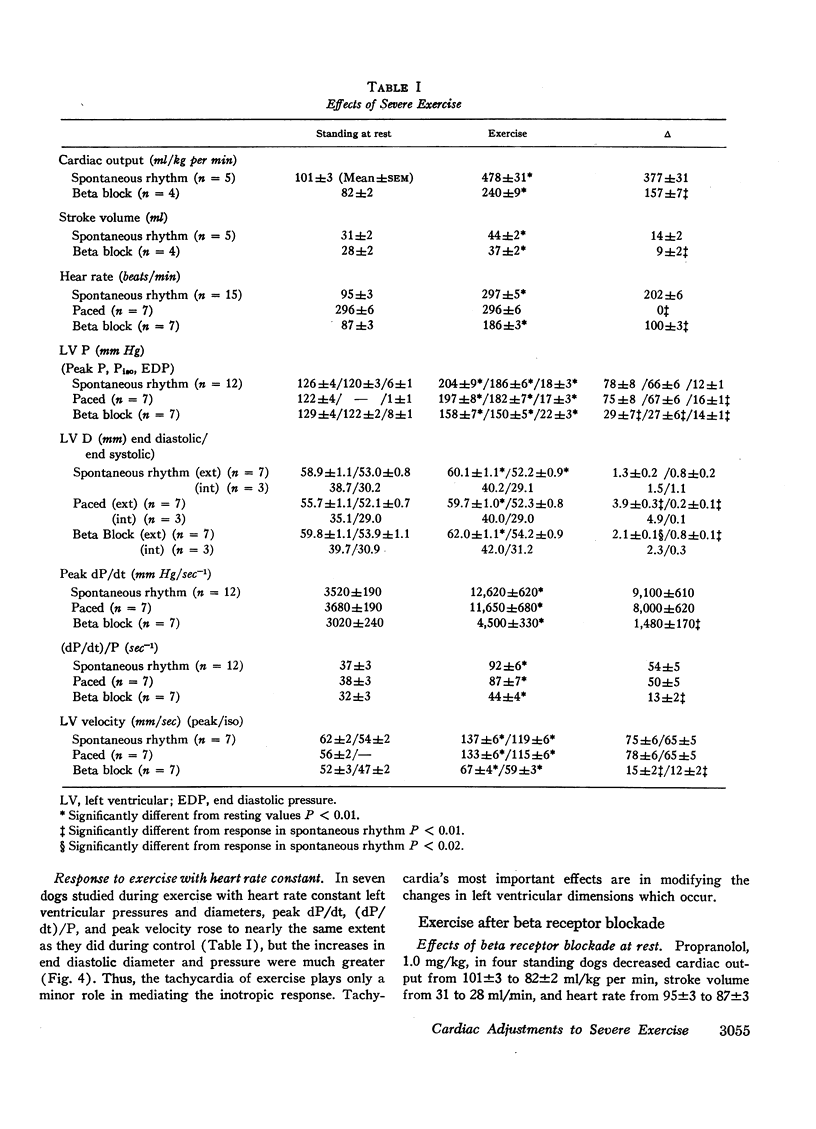

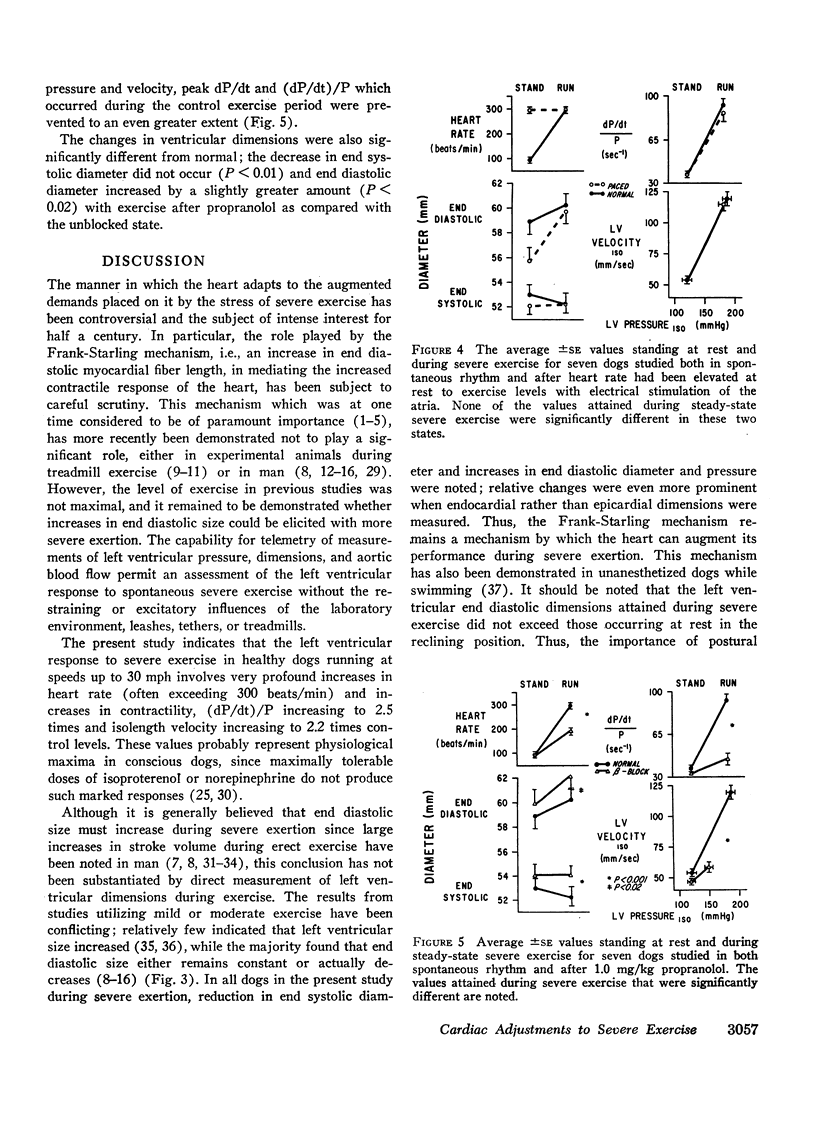

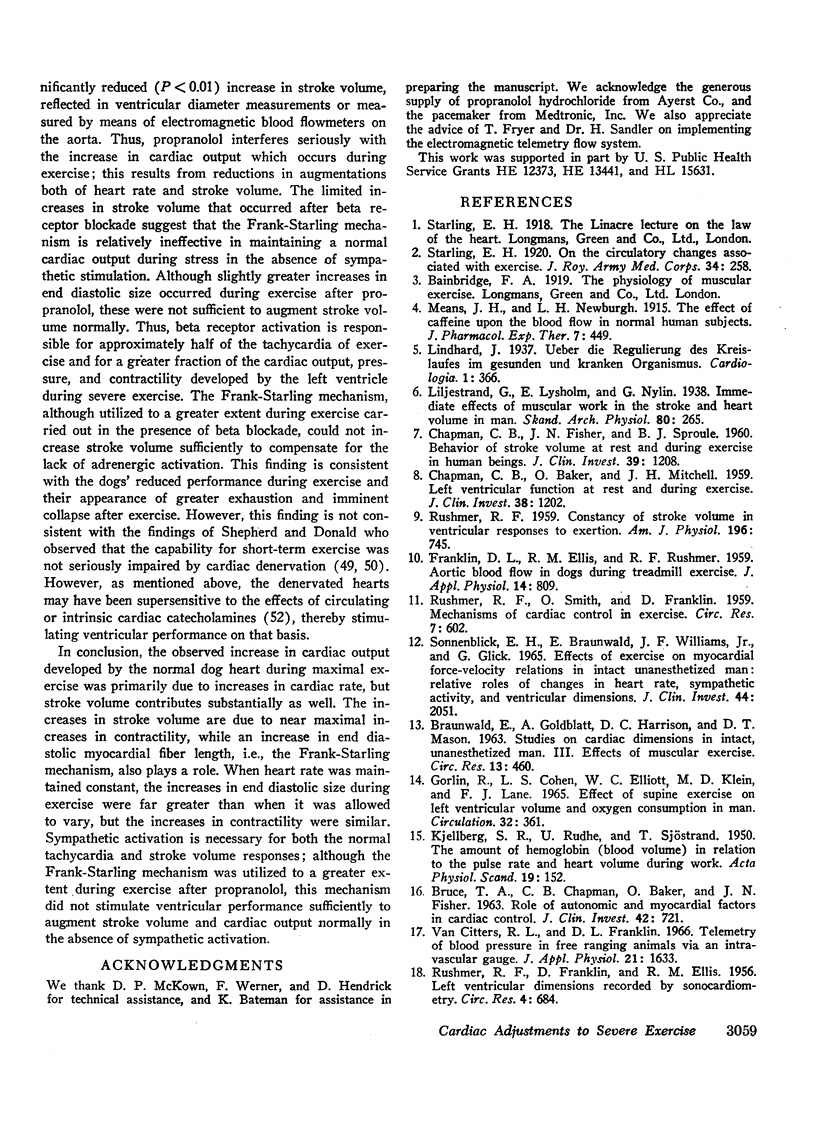
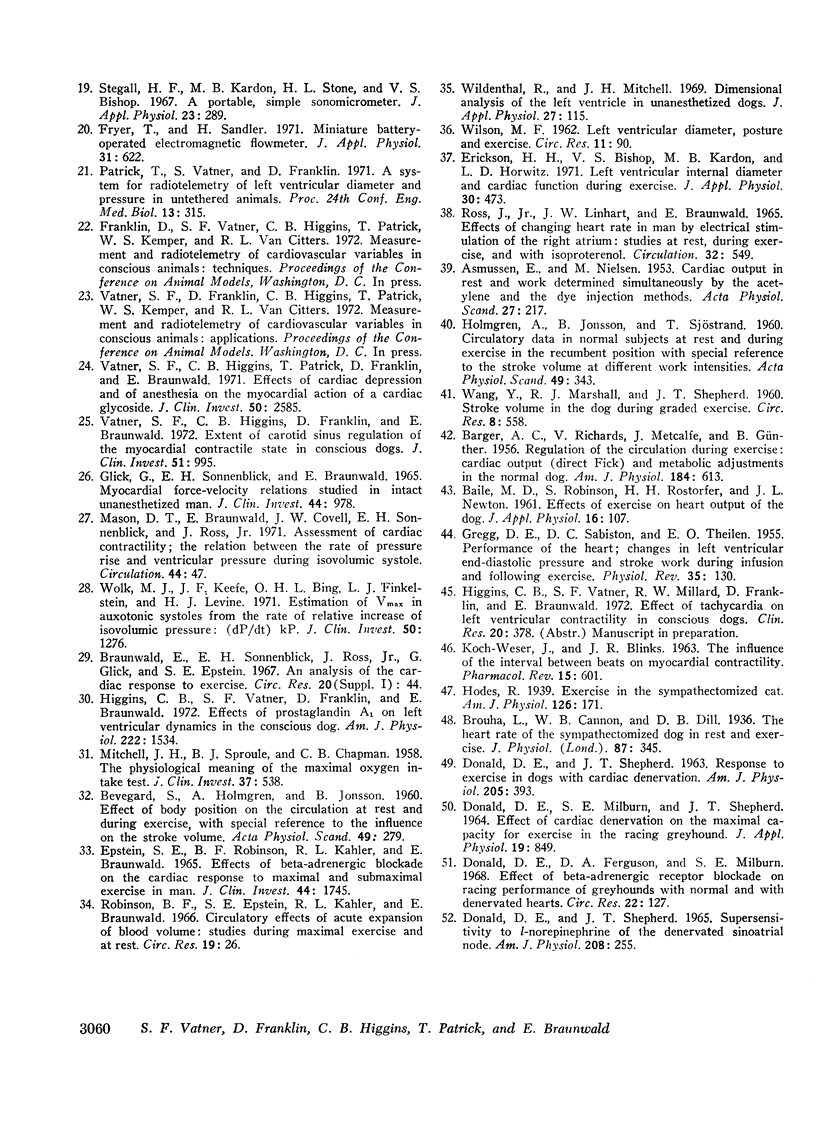
Images in this article
Selected References
These references are in PubMed. This may not be the complete list of references from this article.
- ASMUSSEN E., NIELSEN M. The cardiac output in rest and work determined simultaneously by the acetylene and the dye injection methods. Acta Physiol Scand. 1952;27(2-3):217–230. doi: 10.1111/j.1748-1716.1953.tb00937.x. [DOI] [PubMed] [Google Scholar]
- BAILIE M. D., ROBINSON S., ROSTORFER H. H., NEWTON J. L. Effects of exercise on heart output of the dog. J Appl Physiol. 1961 Jan;16:107–111. doi: 10.1152/jappl.1961.16.1.107. [DOI] [PubMed] [Google Scholar]
- BARGER A. C., RICHARDS V., METCALFE J., GUNTHER B. Regulation of the circulation during exercise; cardiac output (direct Fick) and metabolic adjustments in the normal dog. Am J Physiol. 1956 Mar;184(3):613–623. doi: 10.1152/ajplegacy.1956.184.3.613. [DOI] [PubMed] [Google Scholar]
- BEVEGARD S., HOLMGREN A., JONSSON B. The effect of body position on the circulation at rest and during exercise, with special reference to the influence on the stroke volume. Acta Physiol Scand. 1960 Jul 15;49:279–298. doi: 10.1111/j.1748-1716.1960.tb01953.x. [DOI] [PubMed] [Google Scholar]
- BRUCE T. A., CHAPMAN C. B., BAKER O., FISHER J. N. The role of autonomic and myocardial factors in cardiac control. J Clin Invest. 1963 May;42:721–726. doi: 10.1172/JCI104764. [DOI] [PMC free article] [PubMed] [Google Scholar]
- Brouha L., Cannon W. B., Dill D. B. The heart rate of the sympathectomized dog in rest and exercise. J Physiol. 1936 Sep 8;87(4):345–359. doi: 10.1113/jphysiol.1936.sp003411. [DOI] [PMC free article] [PubMed] [Google Scholar]
- CHAPMAN C. B., BAKER O., MITCHELL J. H. Left ventricular function at rest and during exercise. J Clin Invest. 1959 Jul;38(7):1202–1213. doi: 10.1172/JCI103895. [DOI] [PMC free article] [PubMed] [Google Scholar]
- CHAPMAN C. B., FISHER J. N., SPROULE B. J. Behavior of stroke volume at rest and during exercise in human beings. J Clin Invest. 1960 Aug;39:1208–1213. doi: 10.1172/JCI104136. [DOI] [PMC free article] [PubMed] [Google Scholar]
- DONALD D. E., MILBURN S. E., SHEPHERD J. T. EFFECT OF CARDIAC DENERVATION ON THE MAXIMAL CAPACITY FOR EXERCISE IN THE RACING GREYHOUND. J Appl Physiol. 1964 Sep;19:849–852. doi: 10.1152/jappl.1964.19.5.849. [DOI] [PubMed] [Google Scholar]
- DONALD D. E., SHEPHERD J. T. RESPONSE TO EXERCISE IN DOGS WITH CARDIAC DENERVATION. Am J Physiol. 1963 Aug;205:393–400. doi: 10.1152/ajplegacy.1963.205.2.393. [DOI] [PubMed] [Google Scholar]
- DONALD D. E., SHEPHERD J. T. SUPERSENSITIVITY TO L-NOREPINEPHRINE OF THE DENERVATED SINOATRIAL NODE. Am J Physiol. 1965 Feb;208:255–259. doi: 10.1152/ajplegacy.1965.208.2.255. [DOI] [PubMed] [Google Scholar]
- Donald D. E., Ferguson D. A., Milburn S. E. Effect of beta-adrenergic receptor blockade on racing performance of greyhounds with normal and with denervated hearts. Circ Res. 1968 Feb;22(2):127–134. doi: 10.1161/01.res.22.2.127. [DOI] [PubMed] [Google Scholar]
- ELLIS R. M., FRANKLIN D. L., RUSHMER R. F. Left ventricular dimensions recorded by sonocardiometry. Circ Res. 1956 Nov;4(6):684–688. doi: 10.1161/01.res.4.6.684. [DOI] [PubMed] [Google Scholar]
- Epstein S., Robinson B. F., Kahler R. L., Braunwald E. Effects of beta-adrenergic blockade on the cardiac response to maximal and submaximal exercise in man. J Clin Invest. 1965 Nov;44(11):1745–1753. doi: 10.1172/JCI105282. [DOI] [PMC free article] [PubMed] [Google Scholar]
- Erickson H. H., Bishop V. S., Kardon M. B., Horwitz L. D. Left ventricular internal diameter and cardiac function during exercise. J Appl Physiol. 1971 Apr;30(4):473–478. doi: 10.1152/jappl.1971.30.4.473. [DOI] [PubMed] [Google Scholar]
- FRANKLIN D. L., ELLIS R. M., RUSHMER R. F. Aortic blood flow in dogs during treadmill exercise. J Appl Physiol. 1959 Sep;14:809–812. doi: 10.1152/jappl.1959.14.5.809. [DOI] [PubMed] [Google Scholar]
- Fryer T. B., Sandler H. Miniature battery-operated electromagnetic flowmeter. J Appl Physiol. 1971 Oct;31(4):622–628. doi: 10.1152/jappl.1971.31.4.622. [DOI] [PubMed] [Google Scholar]
- GLICK G., SONNENBLICK E. H., BRAUNWALD E. MYOCARDIAL FORCE-VELOCITY RELATIONS STUDIED IN INTACT UNANESTHETIZED MAN. J Clin Invest. 1965 Jun;44:978–988. doi: 10.1172/JCI105215. [DOI] [PMC free article] [PubMed] [Google Scholar]
- GREGG D. E., SABISTON D. C., THEILEN E. O. Performance of the heart: changes in left ventricular end-diastolic pressure and stroke work during infusion and following exercise. Physiol Rev. 1955 Jan;35(1):130–136. doi: 10.1152/physrev.1955.35.1.130. [DOI] [PubMed] [Google Scholar]
- Gorlin R., Cohen L. S., Elliott W. C., Klein M. D., Lane F. J. Effect of supine exercise on left ventricular volume and oxygen consumption in man. Circulation. 1965 Sep;32(3):361–371. doi: 10.1161/01.cir.32.3.361. [DOI] [PubMed] [Google Scholar]
- HOLMGREN A., JONSSON B., SJOSTRAND T. Circulatory data in normal subjects at rest and during exercise in recumbent position, with special reference to the stroke volume at different work intensities. Acta Physiol Scand. 1960 Aug 25;49:343–363. doi: 10.1111/j.1748-1716.1960.tb01957.x. [DOI] [PubMed] [Google Scholar]
- Higgins C. B., Vatner S. F., Franklin D., Braunwald E. Effects of prostaglandin A 1 on left ventricular dynamics in the conscious dog. Am J Physiol. 1972 Jun;222(6):1534–1538. doi: 10.1152/ajplegacy.1972.222.6.1534. [DOI] [PubMed] [Google Scholar]
- KOCH-WESER J., BLINKS J. R. THE INFLUENCE OF THE INTERVAL BETWEEN BEATS ON MYOCARDIAL CONTRACTILITY. Pharmacol Rev. 1963 Sep;15:601–652. [PubMed] [Google Scholar]
- MITCHELL J. H., SPROULE B. J., CHAPMAN C. B. The physiological meaning of the maximal oxygen intake test. J Clin Invest. 1958 Apr;37(4):538–547. doi: 10.1172/JCI103636. [DOI] [PMC free article] [PubMed] [Google Scholar]
- Mason D. T., Braunwald E., Covell J. W., Sonnenblick E. H., Ross J., Jr Assessment of cardiac contractility. The relation between the rate of pressure rise and ventricular pressure during isovolumic systole. Circulation. 1971 Jul;44(1):47–58. doi: 10.1161/01.cir.44.1.47. [DOI] [PubMed] [Google Scholar]
- RUSHMER R. F. Constancy of stroke volume in ventricular responses to exertion. Am J Physiol. 1959 Apr;196(4):745–750. doi: 10.1152/ajplegacy.1959.196.4.745. [DOI] [PubMed] [Google Scholar]
- RUSHMER R. F., SMITH O., FRANKLIN D. Mechanisms of cardiac control in exercise. Circ Res. 1959 Jul;7(4):602–627. doi: 10.1161/01.res.7.4.602. [DOI] [PubMed] [Google Scholar]
- Ross J., Jr, Linhart J. W., Brauwald E. Effects of changing heart rate in man by electrical stimulation of the right atrium. studies at rest, during exercise, and with isoproterenol. Circulation. 1965 Oct;32(4):549–558. doi: 10.1161/01.cir.32.4.549. [DOI] [PubMed] [Google Scholar]
- Sonnenblick E. H., Braunwald E., Williams J. F., Jr, Glick G. Effects of exercise on myocardial force-velocity relations in intact unanesthetized man: relative roles of changes in heart rate, sympathetic activity, and ventricular dimensions. J Clin Invest. 1965 Dec;44(12):2051–2062. doi: 10.1172/JCI105312. [DOI] [PMC free article] [PubMed] [Google Scholar]
- Stegall H. F., Kardon M. B., Stone H. L., Bishop V. S. A portable, simple sonomicrometer. J Appl Physiol. 1967 Aug;23(2):289–293. doi: 10.1152/jappl.1967.23.2.289. [DOI] [PubMed] [Google Scholar]
- Van Citters R. L., Franklin D. L. Telemetry of blood pressure in free-ranging animals via an intravascular gauge. J Appl Physiol. 1966 Sep;21(5):1633–1636. doi: 10.1152/jappl.1966.21.5.1633. [DOI] [PubMed] [Google Scholar]
- Vatner S. F., Higgins C. B., Franklin D., Braunwald E. Extent of carotid sinus regulation of the myocardial contractile state in conscious dogs. J Clin Invest. 1972 Apr;51(4):995–1008. doi: 10.1172/JCI106893. [DOI] [PMC free article] [PubMed] [Google Scholar]
- Vatner S. F., Higgins C. B., Patrick T., Franklin D., Braunwald E. Effects of cardiac depression and of anesthesia on the myocardial action of a cardiac glycoside. J Clin Invest. 1971 Dec;50(12):2585–2595. doi: 10.1172/JCI106759. [DOI] [PMC free article] [PubMed] [Google Scholar]
- WANG Y., MARSHALL R. J., SHEPHERD J. T. Stroke volume in the dog during graded exercise. Circ Res. 1960 May;8:558–563. doi: 10.1161/01.res.8.3.558. [DOI] [PubMed] [Google Scholar]
- WILSON M. F. Left ventricular diameter, posture, and exercise. Circ Res. 1962 Jul;11:90–95. [PubMed] [Google Scholar]
- Wildenthal K., Mitchell J. H. Dimensional analysis of the left ventricle in unanesthetized dogs. J Appl Physiol. 1969 Jul;27(1):115–119. doi: 10.1152/jappl.1969.27.1.115. [DOI] [PubMed] [Google Scholar]
- Wolk M. J., Keefe J. F., Bing O. H., Finkelstein L. J., Levine H. J. Estimation of Vmax in auxotonic systoles from the rate of relative increase of isovolumic pressure: (dP-dt)kP. J Clin Invest. 1971 Jun;50(6):1276–1285. doi: 10.1172/JCI106606. [DOI] [PMC free article] [PubMed] [Google Scholar]





